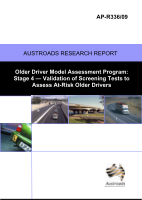Road Safety

Older Driver Model Assessment Program: Stage 4 - Vaildation of Screening Tests to Assess At-Risk Older Drivers
- Publication no: AP-R336-09
- ISBN: 978-1-921551-24-6
- Published: 26 March 2009
- PDF (free) Download
Older drivers are over represented in serious injury and fatal crash rates based on distance travelled. While their physical frailty is a contributing factor, ageing may also result in unacceptably diminished driving skills for a minority of older drivers. With the growing number of older drivers, their serious injury and fatal crash levels (whatever the underlying causes) could as much as triple over the coming decades without appropriate interventions.
- Project Manager
- Prepared by
- 1. THE AUSTROADS OLDER DRIVER MODEL ASSESSMENT PROGRAM: PROGRESS TO DATE
- 1.1. Background
- 1.2. Stage 1
- 1.3. Stage 2
- 1.4. Stage 3
- All three tests had a statistically significant relationship with performance on the on-road driving test. The usefulness of the three tests in a licensing environment was also measured using a hypothetical scenario. To be useful, a test needed to:
-  identify ‘safe’ drivers (as measured by the on-road test) with 80% or greater probability
-  identify ‘unsafe’ drivers (as measured by the on-road test) with 65% or greater probability
-  leave a maximum of 50% of drivers as ‘doubtful’ and requiring further assessment.
- Depending upon the scoring thresholds used, both GRIMPS and CALTEST met all three criteria. While DriveABLE failed to meet one of the criteria (it identified ‘unsafe’ drivers with only 51% probability), it did produce a substantially lower proportion
- 2. RESEARCH FINDINGS ON OLDER DRIVER LICENSING PROCEDURES
- 2.1. Different approaches to older driver licensing
- 2.2. Research evidence RELATED to the validity of age-based mandatory assessment
- 2.3. Alternative Licensing Strategies
- 2.4. Research evidence Related to the Validity of Key Screening Tests
- 2.4.1. HSD
- 2.4.2. UFOV®
- 2.4.3. MaryPODS
- 2.4.4. Some conclusions about the usefulness of the screening tests in a licensing context
- 3. AIMS
- 4. METHOD
- 4.1. Recruitment of Cases and Controls
- 4.2. Assessment Procedures
- 4.3. Assessment Instruments
- 4.3.1. The HSD
- 4.3.2. The CALTEST
- 4.3.3. Driver Questionnaire
- 4.3.4. Structured health assessment
- 4.3.5. Structured on-road driving assessment
- 4.4.1. Analysis of test performance using a two-level outcome: Cases v Controls
- 4.4.2. Analysis of test performance using a three-level outcome: Cases v Controls.
- 5. RESULTS
- 5.1. Recruitment Rates
- 5.2. Demographic and Driving Patterns/Exposure Measures
- 5.3. Analysis of test performance using a two-level outcome to identify safe drivers
- 5.4. Analysis of test performance USING a three-level outcome
- 6. DISCUSSION
- 6.1. Analysis of test performance using a two-level outcome: Cases vs. Controls
- 6.2. Analysis of test performance to enable a three-level outcome
- 6.3. Analysis of test performance using a two-level outcome and Different Safety Criteria
- 6.4. A Limited Demonstration of the Austroads Older Driver Licensing Model
- 7. CONCLUSIONS
- 8. REFERENCES
- APPENDIX 1: DRIVER EVALUATION QUESTIONNAIRE
- APPENDIX 2: OCCUPATIONAL THERAPIST - HEALTH RATING
- APPENDIX 3: ON ROAD ASSESSMENT FORM
- APPENDIX 4: ANALYSES TO IDENTIFY ‘FAIL’ DRIVERS
- APPENDIX 5: AVOIDANCE OF DRIVING SITUATIONS
Related publications
Latest Road Safety News
